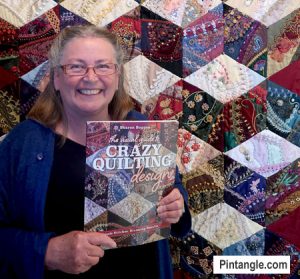I thought people might like to see more of how I use a use a studio journal as a swatch book.

Friends often give me bits and pieces of fabric and lace to use in my stitching. When I use them I like to know who gave them to me and/or where various bits and pieces come from. I also like to record what the fabric is made of (if I know). A few years ago now, I started to use a studio journal as a swatch book to record information such as what it is, when I got it, who gave it to me and where I obtained various bits and pieces.
Swaps and gifts are recorded this way in my studio/visual journal. In the case of gifts like this I take a photo and keep a 1 inch sample swatch in to my visual journal. I also do this with braids, lace, and threads. The only time I don’t so it is if the piece sent is less than 6 inches long in the case of lace, ribbon and braids and less than a yard/meter if it is a thread.
I use double sided sticky tape to attach the samples, glue the photo in and (not seen to protect my friends privacy as it has her address on it) on the other page I have the letter Lynn wrote. Notes are often added too! Obviously it does not keep track of every button or bead but it does record the bulk of what I receive.
Using a visual/studio journal as in part a swatch book is one way of recording not only where things come from but what influences you. All sorts of things end up in my journal as it is all part of the process and I constantly encourage people to keep them.
If you are interested in Studio Journals the category on this site is here.
Have you seen my Crazy Quilting book?

My book The Visual Guide to Crazy Quilting Design: Simple Stitches, Stunning Results shares detailed practical methods about how to design and make a crazy quilt. From fabric choice, to balancing colour, texture, and pattern, in order to balance and direct the eye around the block. I cover how to stitch, build decorative seam treatments in interesting and creative ways. My book is profusely illustrated as my aim is to be practical and inspiring.
Please note if you buy one of my books via this link as an Amazon Associate, I earn from qualifying purchases.


Hi. I love the idea of keeping a visual journal to keep track of my things. I’m just not sure of how to get started. I mean… Do I use a notebook or scrapbook? How much money should I expect to spend? Everytime I see how expensive the scrapbooks are, I tell myself I’ll wait until the next time I’m here. Then I do the same thing all over again. But I do think having a visual record would help me a great deal. My memory really stinks and I’m not good at keeping a diary or recordkeeping. Any suggestions? Brenda
Yep keeping track of where ideas spring from is important – I might take an idea and run with it miles away from the originial but its is still good idea to credit sources and be aware of the cultural context it came from
I like the fact that you noted the influence factor as well as sources during any given time period.
Thanks for the idea. That’s probably better than leaving them in baggies with labels. =)